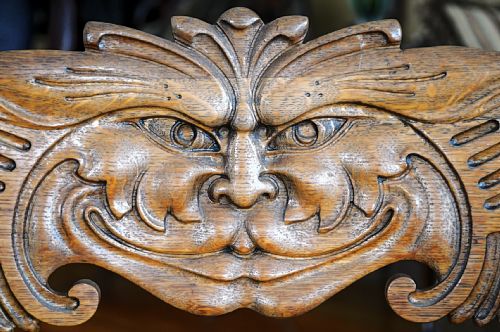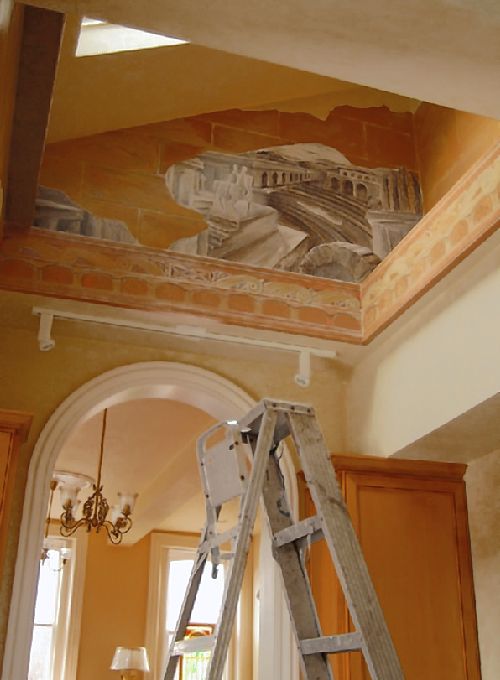
Category Archive: Historic Properties
-
Children’s Museum Has Bulk of Funds to Build Park
Friday, January 21, 2011By Diana Nelson Jones, Pittsburgh Post-GazetteThe Children’s Museum is $2.2 million away from raising the funds it needs to transform the sunken concrete square outside its doors into the Allegheny Public Square Park and make upgrades inside the museum.
Officials Thursday announced they had raised $6.3 million of the $8.5 million needed and that the remainder would be solicited as public donations.
The bulk of the money to date has come from foundations. A $250,000 challenge grant from the Buhl Foundation will match $1 for every $2 contributed by the public.
The existing square was created in the 1960s as part of the Allegheny Center Mall. A sunken area housed a fountain encircled by amphitheater-like seating. The area now is a walk-through zone, sometimes used by skateboarders but otherwise ghostly.
The museum chose San Francisco landscape architect Andrea Cochran in a design competition in 2007, when it embarked on its capital campaign. Ms. Cochran’s design for the new park calls for native plants, a meadow, 75 additional trees, solar lighting, a rain garden and a V-shaped walkway with benches and movable seats and tables.
The park’s art feature will be a stainless steel sculpture by Ned Kahn. Called “Cloud Arbor,” the piece will stand as rows of stainless steel tubes with nozzles to create “a sphere of mist,” said museum executive director Jane Werner. “It is a companion to our wind sculpture,” called “Articulated Cloud,” which Mr. Kahn also designed as 43 panels on the building that create the illusion that the building is moving with the wind.
A north-to-south row of cypress trees along Children’s Way will be kept while about 10 others will be replaced, said Ms. Cochran, adding that arborists had determined them to be unhealthy.
Plants have been chosen for their contributions to green design, she said. “We are teaching by example, with plants that don’t need pesticides or fertilizers.”
“Everything we all say we care about — the environment, green space and kids — all comes together here,” said state Sen. John Pippy, R-Moon, a museum board member.
The project’s budget will also cover alterations of the museum’s nursery, store and cafe.
“We are hoping to break ground sometime this year,” said Ms. Werner. The project may be completed next year.
-
The Making of a Mural: Series of Coincidences Led to Collaboration Between Artist and North Side Homeowner
Saturday, January 15, 2011
By Kevin Kirkland, Pittsburgh Post-Gazette
Artist Ken Heusey in front of the mural he created for David McAnallen's renovated kitchen on the North Side. Pam Panchak / Post-Gazette
Life is sometimes like a movie script. Or maybe it just seems that way to Ken Heusey because he worked in Hollywood for 16 years.
Only in a movie would absentmindedly leaving your cell phone on a table in an airport restaurant lead to painting murals in a South Side restaurant and a restored North Side townhouse. The work has been a triumph and a treat for Mr. Heusey, an accomplished photographer and native of Fombell, Beaver County, who did fashion shoots and lighting on movie sets, including making Matt Damon look good in “Oceans 12.”
David McAnallen, who is finishing a nine-year renovation of an 1860s brick townhouse in the North Side’s Manchester neighborhood, is glad fate brought them together. No one else could have imagined and created the classical mural that draws your eyes up the moment you step into his kitchen.
“The collaboration with Ken was wonderful. As you walk around, you’re captivated. It sucks you in,” said Mr. McAnallen, a psychologist.
Mr. Heusey, 46, was heading back to Los Angeles a year-and-a-half ago when he stopped to eat at the T.G.I. Friday’s at the Pittsburgh International Airport and left his cell phone. Upon his return, he stopped in and asked to see the manager who was holding it for him. The server he spoke with recognized him — She was his 10th-grade date for the homecoming dance at Riverside High School.
That connection led to an introduction to the owners of Hofbrauhaus Pittsburgh on the South Side. Last fall, Mr. Heusey painted a large two-section mural of 19th-century barmaids and beer drinkers on the terrace overlooking the beer garden. He was finishing that project when he met Mr. McAnallen while the two men were working out at the North Side YMCA. When Mr. McAnallen saw his photos of the Hofbrauhaus project, he decided he’d found the artist to decorate his newly renovated kitchen.
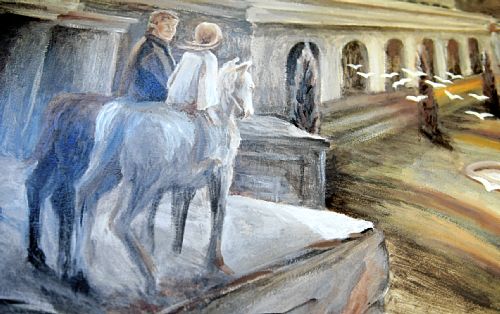
A detail from the mural Ken Heusey painted for David McAnallen's renovated kitchen. Pam Panchak / Post-Gazette
“I had thought about a mural before, but it never happened,” he recalled. “The space is so angular. I wanted to soften the angles.”
The space is an alcove around a new Velux skylight Mr. McAnallen added to the kitchen. Although Mr. Heusey had in mind a prominent spot visible from the doorway, it ended up closer to the ceiling, revealing itself gradually as a visitor enters the kitchen. The homeowner wanted something subtle.
“It was too big, too bold there,” Mr. Heusey agreed.
The artist suggested a trompe l’oeil painting in which old sandstone walls and a fragment of an old mural peek out from beneath layers of plaster. His inspiration for the classical scene came from a Gustave Dore engraving, “Isaiah’s Vision of the Destruction of Babylon.” He liked the mood of the drawing, especially the stormy sky. Mr. McAnallen liked it, too, but he asked the artist to take out the debris. He also added a pond similar to the one the homeowner had installed in his side yard. Isaiah was replaced with one horseman, then two.
“I like to create a story,” Mr. Heusey said, adding that he leaves the story’s details to the viewers’ imagination.
He copied the pattern of the faux stone corbeling beneath the scene from a nearby building and the carved lion’s face from an oak chair that is a McAnallen family heirloom.
Mr. Heusey spent about three weeks working on the painting, interrupted by the holidays. Before he started, he warned Mr. McAnallen that he would probably have concerns in the middle of the project, when he was still roughing in the design. He was right:
“I panicked only one time,” Mr. McAnallen admitted. “A lot of orange was coming through. I thought ‘Did I do the right thing?'”

David McAnallen at his home on Sheffield Street in Manchester on the North Side. Pam Panchak / Post-Gazette
The artist explained that the orange was underpainting and that it would not look that way in the final painting. And it doesn’t.
The two men declined to say what the project cost. Mr. Heusey, who spends about half of his time painting murals and the other half doing commercial photography, said his price depends upon the size, detail and complexity of the project. He says collaboration between artist and client yields a painting that pleases both.
“We let it evolve,” he said. “By going back and forth, we created something better.”
To contact Ken Heusey, call 310-963-6772 or go to www.khprod.com, which includes photos taken as he worked on the McAnallen project.
-
Denis Theatre Foundation Names Executive Director
Thursday, January 13, 2011
Pittsburgh Post-GazetteThe Denis Theatre Foundation on Wednesday named Valerie Golik, the former executive director of The Pittsburgh Philharmonic, as its new executive director.
She replaces board member Jennifer Smokelin, who has served as interim director since the fall.
“We are delighted that Valerie is joining the Denis Theatre Foundation,” Ms. Smokelin said in a news release. “She brings with her an excellent background in arts management, programming, and a strong track record in fundraising and planning.”
When Ms. Golik, of Marshall, assumes the role Jan. 17, she will direct the foundation’s goal of restoring and re-opening the Denis Theatre on Washington Road in Mt. Lebanon. The theater, which opened in 1938, closed in 2004 in a state of disrepair. The nonprofit Denis Theatre Foundation formed in 2007 and began a fundraising campaign, with the goal of purchasing the building and restoring it as an independent film theater and community cultural center.
In September, the foundation announced it had raised enough money to purchase the building. Ms. Golik will assist with the capital campaign to raise $2.5 million to open the first of three planned screens. So far, the foundation has raised $900,000.
The foundation hopes to open the first screen in mid-2012.
“We are counting on broad support from individuals, businesses and charitable foundations from throughout the Pittsburgh area,” Ms. Golik said. “Once re-opened, the Denis will be a true regional asset.”
-
Friendship May Get Aldi Grocery
Tuesday, January 11, 2011By Mark Belko, Pittsburgh Post-GazetteDiscount grocer Aldi appears to be headed to the East End as part of the redevelopment of a former car dealership.
Michigan-based Warner Pacific Properties is expected to brief the city planning commission today about its plans to convert the Day Automotive dealership into a grocery, offices and other retail uses.
The grocer in question is believed to be Aldi, although Leslie Peters, an attorney for Warner Pacific, said the developer did not yet have an agreement with any particular store.
Asked if Warner Pacific were talking to Aldi, Ms. Peters replied, “I think you can infer that.” City Councilman William Peduto, who represents the area, said Warner Pacific had stated that Aldi would be the grocer.
The developer is proposing an 18,000-square-foot grocery at the site at Baum Boulevard and Roup Street in Friendship. It is also planning 44,000 square feet of office space and 3,000 square feet of retail space.
Ms. Peters said Warner Pacific planned to keep the exterior intact.
The building, with a corner tower that once displayed pulsating light after dark, has some historic value. Built in the early 1930s as a Chrysler sales and service building, it remained as an auto dealership until it was closed in 2009 by the Day Automotive Group.
“We’ll be reusing the existing building,” Ms. Peters said. “We believe it’s a significant structure, at least for Pittsburghers. Everybody knows the building.”
She added that the developer did plan some interior renovations to upgrade the space. The total project cost is estimated at $4 million.
Because the property is a former auto dealership, Mr. Peduto said there are ramps within it that will allow for parking on the upper floors. The grocery will be on the first floor. He said an adjacent structure would be converted for office use.
Mr. Peduto said the project has the support of the Baum-Centre Initiative group. Through a community process, the developer is also addressing concerns about traffic patterns and other issues, he said.
After a planning commission briefing today, Warner Pacific is expected to appear before the city’s Zoning Board of Adjustment Thursday to request a special exception that would allow the property to be used for a grocery and office space.
Ms. Peters said the developer hoped to get all permits needed for the project by February or March and then start construction.
-
Buying Here: Oakmont
A fine arts-and-craft home for a young family
Sunday, January 09, 2011By Gretchen McKay, Pittsburgh Post-Gazette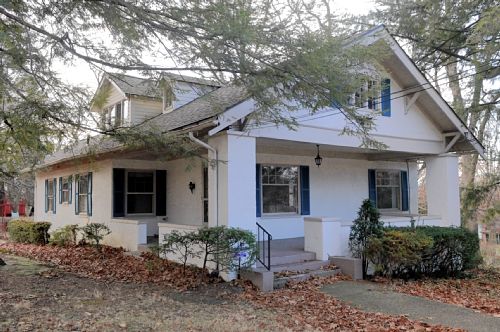
This home on California Avenue in Oakmont is on the market for $249,900. Bob Donaldson / Post-Gazette
Oakmont is probably best known for its luxurious country club, home to a famously difficult golf course that’s hosted more combined USGA and PGA championships than any other course in America. But its roots actually were planted in industry; early employers along the Allegheny River included Allegheny Valley Railroad, Woodings-Verona Tool Works and Agnew & Co., one of the most prolific glass companies in Pittsburgh at the turn of the 20th century.
Along with the elegant (and uber-expensive) homes that sprang up on Hulton Road about the same time as the club, the borough is blessed with a variety of more modest turn-of-the-century homes. Pretty as a picture is a 11/2-story Craftsman bungalow at 710 California Ave. (MLS No. 842126), constructed 11 years after Oakmont incorporated as a borough in 1889. It is being offered by Howard Hanna Real Estate’s Shadyside office for $249,900 (www.howardhanna.com; 412-361-4000).
The Arts and Crafts Movement flourished in England in the mid 1800s. Yet the style — marked by architectural simplicity and natural materials — didn’t catch on in the U.S. until decades later, in the early 1900s. After the fussy opulence of the Victorian era, American homeowners welcomed uncomplicated designs that were easy to envision, build and maintain. Architect/furniture designer Gustav Stickley’s “The Craftsman” magazine, first published in 1901, proved so popular that the 200-plus house plans he designed for its pages eventually were published in two books.
Situated on a double corner lot within easy walking distance of the shops and restaurants on Allegheny River Boulevard, this house features the style’s characteristic low-pitched, gabled roof and covered front porch. Inside, the rooms are large, with minimal ornamentation, high ceilings and lots of windows. Some could some updating.
First-floor bedrooms might seem like a Baby Boomer invention, but they actually were fairly common in Craftsman bungalows. This 2,500-square-foot house has two on the main level, including a 13-by-13-foot master, plus two more upstairs. Something else that will appeal to modern sensibilities: There’s a full bath on both floors.
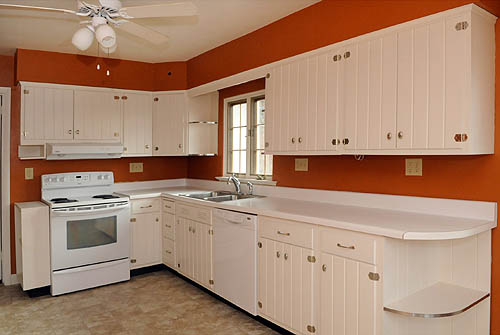
The 15-by-10-foot eat-in kitchen opens onto a 15-by-14-foot formal dining room. Bob Donaldson/Post-Gazette
The updated, eat-in kitchen measures 15 by 10 feet and is brightened by white wood cabinets and white appliances. It opens onto a 15-by-14-foot formal dining room, which adjoins a 20-by-14-foot living room with built-in bookcases and a working fireplace. Hardwood floors run throughout the first floor; out back is a one-car detached garage.
The large yard and quiet, tree-lined street make it a perfect starter house for a young family, says listing agent Justin Cummings. With most of the living space on the first level, it also should appeal to older couples who are downsizing but still need bedrooms for grandchildren and other visitors.
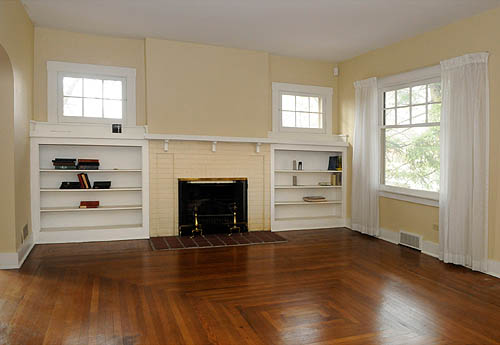
The 20-by-14-foot living room features built-in bookcases and a working fireplace. Hardwood floors run throughout the first floor. Bob Donaldson/Post-Gazette
The current owner paid $265,000 for the house in 2007. It has a 2010 full market value of $175,000
(www2.county.allegheny.pa.us).
In the past three years, eight homes have changed hands on California Avenue, ranging in price from $167,500 in May 2007 to $285,000 in July 2008 (www.realstats.net).
There will be an open house from 1 to 4 p.m. today. For more information, contact Justin Cummings of Howard Hanna’s Shadyside office at 412-361-4000 or www.howardhanna.com.
-
Owner Wants to Raze Iron City Building
Commission worries demolition will hamper future development at the historic Lawrenceville landmarkMonday, January 10, 2011By Diana Nelson Jones, Pittsburgh Post-Gazette
The pipe shop portion of the closed Iron City Brewery is falling apart at the Lawrenceville landmark, on which the city has bestowed historic status. Bill Wade/Post-Gazette
Iron City Brewing Co. president Tim Hickman sounded urgent Dec. 1 when he asked the Historic Review Commission to let him tear down one of five buildings the city had granted historic status earlier in the year.
“The roof has collapsed,” he said, describing the original ice house in the former brewing complex in Lawrenceville. “The wooden I-beams have rotted and collapsed and the west wall is collapsing.”
Last week, the commission reconvened for a hearing, and Mr. Hickman was fighting to calm his agitation as the discussion drew out. A photo projected onto a screen showed twisted metal trusses hanging in a blue background — a rectangle of sky through the roof.
The brewing company had been cited by the Bureau of Building Inspection to abate the condition, which acting bureau chief John Jennings called “very dilapidated.” But the Historic Review Commission had a longer-term concern about the building, which dates to the 1890s.
And that concern is this: Would demolition of the old ice house prove to be a terrible mistake, jeopardizing a developer’s chances of getting a 20 percent tax break should this property become part of the National Register of Historic Places?
Although Mr. Hickman said a year ago that he embraced the historic status for the economic redevelopment possibilities, he told the commission last week he has not sought national status.
This raised some commissioners’ eyebrows.
Any future development project would almost assuredly depend on the tax credit, without which the company could be stuck with a white elephant.
“Is it your intention to seek tax credits to market this property?” acting chair Ernie Hogan asked him.
“We are still trying to determine that,” said Mr. Hickman, citing the company’s uncertainty over two other buildings that are unusable unless giant tanks can be removed from them. “If I can’t get them out,” he said, “who cares that it’s historic?”
The city approved historic designation for the complex of buildings in February, which automatically kept the company from dismantling any except for one that was exempted — a non-contributing 1970s rectangle. The company still has headquarters in the original building at 3340 Liberty Ave.
Mr. Hickman originally had wanted to demolish all but the headquarters, but preservation advocates seemed to have convinced him the complex was more valuable intact.
“We’re as concerned with the history as anybody in this town,” he said last week, “but if we lose a life, I don’t care about tax credits. I have security 24/7 running off copper thieves.”
As the owner, Mr. Hickman argued, shouldn’t it be up to him whether he wants tax credits?
Mr. Hogan said the commission is responsible for making sure historic buildings have available resources for preservation.
“If that demolition were to jeopardize the integrity of the assemblage, it could jeopardize any federal money to the site,” Mr. Hogan said. “[Mr. Hickman] would be turning his back on any public subsidies.
“I think this property is important. It could be eligible for federal transportation money [being on a bus route], sustainable communities grants, HUD money, all sorts of money.”
The Penn Brewery in Troy Hill was restored using federal tax credits, he said. Similar restoration “could be a huge economic driver” for the Lawrenceville portal.
Scott Doyle, grant manager for the Pennsylvania Historical & Museum Commission in Harrisburg, said the determination of a building’s importance to an overall site “comes down to hardship or a level of significance.”
One way a building in a historic cluster could get a pass is “if it’s outside the period of significance for the property.” Other provisions exempt properties that “lack significance and do not occupy a major portion of the site, and if evidence is presented to show that retention is not economically feasible.”
The hardship provision applies “if a property is so deteriorated or altered that its integrity has been irretrievably lost,” he said.
In order to review the case, the PHMC would need a structural engineering report, photographs, historic documentation and cost estimates for repair.
The brewing company was a regional economic powerhouse in the late 19th and 20th centuries. Founded in 1861 as Frauenheim, Miller & Company, it brewed one of the country’s first golden lagers. It became the Pittsburgh Brewing Co. in 1899 in a merger of 20 regional breweries.
Among the brewery’s firsts were the snap-top can, the twist-off resealable bottle top, draft beer in cans, aluminum beer bottles and the original light beer, Mark V.
Brewing operations moved to Latrobe in summer 2009.
Last week, Mr. Hickman said he is “trying to embrace this process, but what’s the time limit? I have the city [building inspection] telling me you must do something, so I come here to do something and I’m told ‘Let’s wait.’ ”
The commission is expected to consider demolition in February, when an answer is expected about the building’s importance.
-
Saxonburg Gets $1.4 Million for Main Street
By Tom Fontaine
PITTSBURGH TRIBUNE-REVIEW
Friday, January 7, 2011Saxonburg has received a $1.4 million state grant to make long-awaited improvements along historic Main Street without robbing any of its 19th century charm.
“We’re going to take new materials and create an atmosphere like it was in the 1850s and ’60s,” said Ray Rush, who will oversee the project for the tiny Butler County borough.
Saxonburg’s grant was the largest of six totaling more than $4.4 million announced Thursday by PennDOT. The agency awarded almost $25 million statewide through its Pennsylvania Community Transportation Initiative. The program provided $59.2 million for transportation projects in 2009.
Saxonburg will use its money to install new curbs, brick sidewalks, planter strips with trees, and period lighting along 1,100 feet of Main Street. That will cover roughly half of the area that is recognized as a historic district both nationally and by the state.
The borough can trace its roots to engineer John Roebling, famed for his designs of wire cable and suspension bridges. He designed and developed Saxonburg almost four decades before he began designing the Brooklyn Bridge in the late 1860s.
“It’s important to celebrate the old. It’s something all communities should be concerned about,” Rush said. The work will begin next fall and should be completed in 2012.
The city of Pittsburgh will receive $280,000 for a traffic study in the Strip District and Lawrenceville related to its Allegheny Riverfront Green Boulevard development project. The city wants to help make its largely industrial Allegheny riverfront home to lush green spaces, trails, housing, commercial development and commuter rail.
“This most recent grant will allow us to continue the positive momentum that is happening in these vibrant neighborhoods,” said Mayor Luke Ravenstahl.
Other grant recipients include:
• Richland, $1.3 million, to improve pedestrian access and traffic flow near the intersection of Route 8 and Ewalt Road.
• Airport Corridor Transportation Association, $700,000, to reduce congestion and provide better transit, pedestrian and bicycle access in the Robinson and North Fayette commercial area.
• Washington County, $443,500, to develop 9 miles of recreational trail to complete the Panhandle Trail between Carnegie and Weirton, W.Va.
• Armstrong County, $300,000, to perform a traffic study in Kittanning.
-
Historic Panel Gives a Reprieve to Igloo
Thursday, January 06, 2011By Mark Belko, Pittsburgh Post-GazetteThe Civic Arena has won a bit of a lifeline.
A bid to protect the 49-year-old landmark from demolition got a boost Wednesday when the city’s historic review commission gave preliminary approval to its nomination as a city historic structure.
The 5-1 vote clears the way for a formal hearing Feb. 2 on the proposed designation, one opposed by the Pittsburgh Penguins and the arena’s owner, the city-Allegheny County Sports & Exhibition Authority. John Jennings, acting chief of the city’s Bureau of Building Inspection, cast the no vote.
Even as it gave preliminary approval, the commission stated that the decision was not a determination on the merits of the application for historic status filed by Hill District resident Eloise McDonald.
In fact, nine years ago, the commission gave preliminary approval to the arena’s designation as a historic structure only to reject it in a final vote.
Nonetheless, Ms. McDonald said afterward that she was thinking “very positive” on the chances of getting a final vote in favor of the nomination. But she added it could be a tough sell since Mayor Luke Ravenstahl, who appoints historic review commission members, favors demolition.
“I’m going to stay optimistic to the final decision,” she said. “But like I said, I know the politics of the game.”
However, Ernie Hogan, the commission’s acting chair, said afterward that the mayor is “not telling us what decision to make” on the nomination.
“We have a charter to uphold regarding preservation standards. That’s all he’s saying, do your job,” Mr. Hogan said.
In arguing the case for the nomination, Ms. McDonald said the arena, with its retractable roof, is unique.
To tear it down would be “just awful,” she said. “There’s a lot of young kids, if they would ever see that dome open, there would be a whole lot more support for it. If you’ve never seen it open, you have no idea how extravagant and beautiful it is.”
The preliminary finding is a setback for the SEA and the Penguins, who have the development rights to the land that includes the arena. The team wants to demolish the structure to make way for a residential, office and commercial development.
Travis Williams, the Penguins’ senior vice president of business affairs and general counsel, declined comment on Wednesday’s decision.
But Shawn Gallagher, an attorney for the SEA, said the agency does not believe the Igloo meets the criteria for historic status. Describing Ms. McDonald’s nomination as “frivolous,” he said the same criteria used to nominate the arena eight years ago — and rejected — is being used this time.
And while Ms. McDonald spoke of the marvel of the retractable roof, Mr. Gallagher said it “never really worked” and doesn’t work anymore.
“It’s not worthy of preservation,” he said of the arena, adding it is costing the SEA and taxpayers about $65,000 a month to maintain it.
The Penguins moved from the arena to the Consol Energy Center across the street last summer.
Scott Leib, president of Preservation Pittsburgh, noted that state preservation officials have determined that the building is eligible for the National Register of Historic Places.
“We’re not trying to obstruct progress. We just have a totally different view of what progress is,” he said.
Wednesday’s vote prevents the SEA from demolishing the structure until a final determination is made on its status. However, the agency did not plan to start the razing until spring at the earliest.
Once the historic review commission has completed its work, the nomination must be considered by the city planning commission and city council before the arena’s final fate is known.

